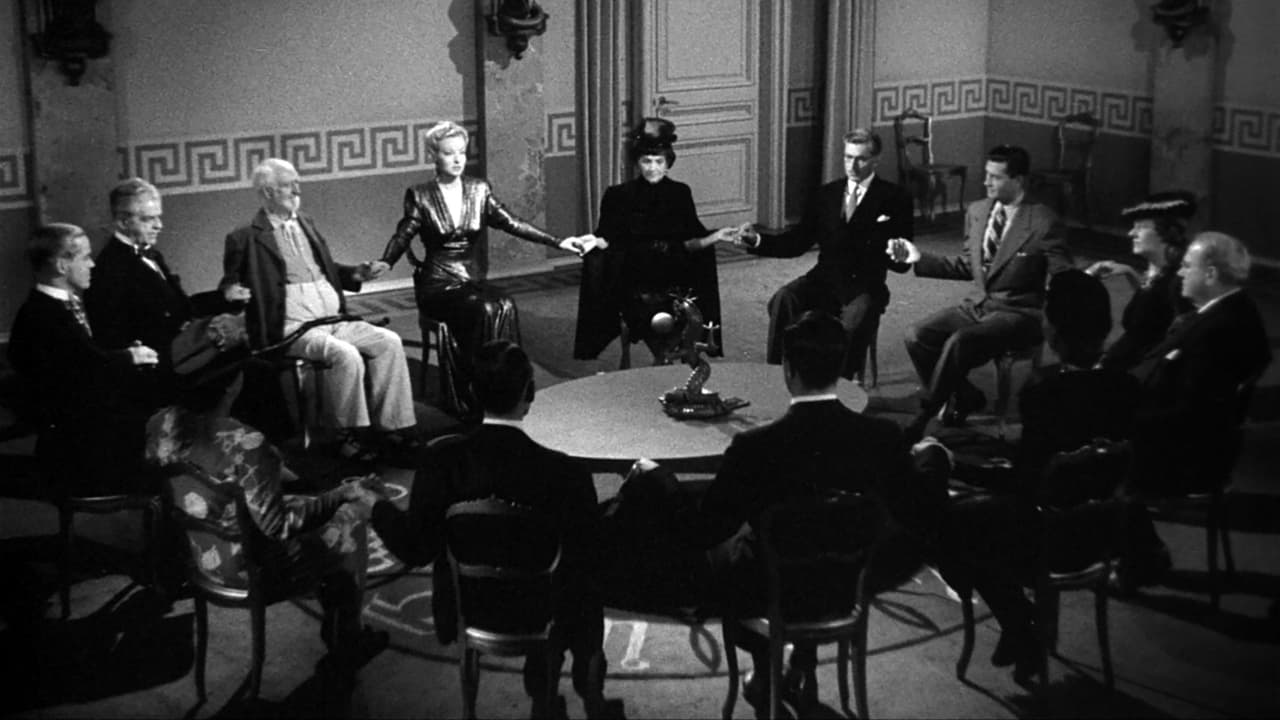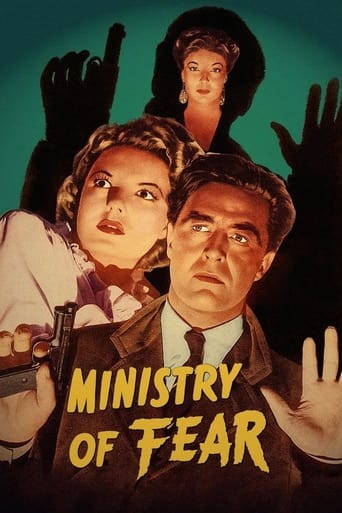

Why so much hype?
... View MoreThere are moments that feel comical, some horrific, and some downright inspiring but the tonal shifts hardly matter as the end results come to a film that's perfect for this time.
... View MoreIt is interesting even when nothing much happens, which is for most of its 3-hour running time. Read full review
... View MoreI think this is a new genre that they're all sort of working their way through it and haven't got all the kinks worked out yet but it's a genre that works for me.
... View MoreThis film is pathetic, beginning with a cake supposedly made out of real eggs won at a fair while the Nazis are carpet-bombing London, continuing with a Dan Duryea who appears and disappears from the movie in less than the blink of your eye, without one ever knowing why he was in it in the first place, to a truly laughable ending. Why is an American in a London home for mental patients at the height of WWII? Despite the wife's mercy-killing line, that is never properly explained and the rot begins right there.Ray Milland never impressed me as an actor (LOST WEEKEND and BIG CLOCK are the exceptions) and he never seems to know what he is doing, apart from always retrieving a gun that can only leave him in trouble with the police.I haven't read Graham Greene's novel, but this is certainly the worst film I ever saw from director Fritz Lang.
... View More****SPOILERS**** Confusing story about a man just released from a mental institution for the mercy killing of his terminally ill wife. Just released mental patient Stephen Neal, Ray Malland, who through winning a cake at a carnival ends up too his neck involved in a Nazi spy ring in London at the hight of the 1940-41 Blitz! The cake contained a reel of microfilm showing where the British defenses were on the Southern English coast that was to prevent a Nazi invasion of the country. Thing started to get a bit crazy when this blind man in the train compartment that he was shearing suddenly went nuts and attacked Neal in order to steal his cake. Not blind at all the blind man ended up getting killed by a German Luftwaffe bomb as he ran, with cake in his hands, from the train.Getting involved with his psychic Mrs, Bellane, Hillary Brooke, who supposedly told him his future at the carnival Neal ends up getting framed for a murder that happened in a séance that she was holding that he attended. Now wanted for murder Neal is on the run from the police for a crime that he didn't commit as well as being a suspected Nazi spy. In fact it turned out that the person that he supposedly murdered at Mrs. Bellane's séance wasn't dead at all but only faked being murdered! Things get even stranger after that with brother & sister act Willi & Carla Hilfe, Carl Esmond & Marjorie Reynolds, popping into the picture who are or not working for the Nazi spy sing, It's soon that Neal starts to get wise in what's going on in the movie and makes his way to both Scotland Yard and the Ministery of Home Security to expose who's involved in all this spying.***SPOILERS*** It's when Neal with the help of Scotland Yard finally finds the missing cake in a bomb crater that everything comes together with it, or the micro film hidden in it, exposing the Nazi future plans for the invasion of England. But it was non other then Carla who broke with her Nazi loving brother Willi and joined the good guys, the British,that not only ended up saving his life but the very fate of the free & civilized world from being taken over by Hitler's Germany! In the end Neal now completely cured from his guilt of killing his wife and exonerated of being a Nazi spy ends up marrying Carla but under no circumstances does he want to have a wedding cake or any other cake at their wedding ceremony.
... View MoreFritz Lang directed this film based on a Graham Greene novel that stars Ray Milland as Stephen Neale, who has just been released from an asylum after two years for the mercy-killing of his terminally ill wife. It is London during WWII, and Stephen stops at a country fête where he correctly guesses the weight of a cake, but after a misunderstanding with a "fortune teller", finds himself mixed up with a spy ring that leads to the fête organizers, one of whom(a beautiful woman played by Marjorie Reynolds) falls in love with Stephen, and helps him evade both the police and enemy agents to uncover the truth. Atmospheric and exciting film may defy credibility at times, but interesting characters and setting make all the difference.
... View MoreThe United Kingdom has long been the home of the spy thriller. While writers in the US like Dashiell Hammett and Raymond Chandler were turning out hard-boiled crime fiction, Britain had people like John Buchan and Grahame Greene writing adventuresome tales of espionage and political intrigue. In cinema too, the best director of spy thrillers was undoubtedly Englishman Alfred Hitchcock, and many of his early British films were in the genre. Ministry of Fear however was an American production, made by Paramount studios, and yet it is set in Britain and is adapted from a Grahame Greene novel.Despite this complete independence from the famous British thrillers of the 30s (which weren't just Hitchcock's by the way, Michael Powell did a few, as did Anthony Asquith), you can see the similarities in theme and plot. As in The 39 Steps, The Man Who Knew Too Much and so forth, the hero is an ordinary citizen who is drawn into events by chance. He finds himself in a nightmare situation where anyone could be an enemy, and he even finds it impossible to prove his own innocence to the authorities. I stress all this to prove the point that these devices were not invented by Hitchcock, even if he popularised them and associated them with his name – they were established features of the spy novel.Being a US production, and seemingly one unable to take advantage of the growing crop of Brit actors in Hollywood, the primary roles in Ministry of Fear go to Americans. Ray Milland was just starting to break through into important dramatic roles, and although this is far from as prestigious as the ones he would soon be getting, it does show off his talent for moulding a new persona. He does a passable British accent, in the days before getting these things right was considered important (cf. Errol Flynn pretending to be a yankee), and gives a realistic look of disorientation to the character which fits in nicely with his innocent bystander status. The only other standout from the cast is Dan Duryea who despite only appearing in a handful of scenes makes a grand impact. Duryea didn't really play authentic types, but that wasn't the point. He was the archetypal creepy villain, and his characters don't have to be particularly active because he was great at constantly projecting the idea that he might be about to do something unpleasant. Take that scene at the tailor's shop, where he dials the number with a pair of scissors – that's a typical and very effective bit of Duryea business.And finally we come to the director, one Fritz Lang. Lang responds fantastically to the material, and emphasises most of all the sense of entrapment in a nightmarish situation. Take the pivotal cake-weigh scene – who but Lang could make a village fete look so eerie? The child's ball bouncing towards Milland as he enters, the absence of bustle or enjoyment, the silence as Duryea arrives, and the absolute, claustrophobic darkness. It's not just gloomy – it has the surrealism of a dream, and really does feel like some symbolic strand of a nightmare. Also characteristic of Lang is the way he uses odd angles and compositions, not so much for expressionistic value but to satisfy his own aesthetic taste, full of diagonals and art deco starkness. It gives us this sense of displacement as familiar settings and objects become geometric patterns. Hollywood didn't have a lot of cash to spare during the war (for a good example of this check out how minimalist Paramount's "big" Technicolor "epic" of the war years, For Whom the Bell Tolls, is), and oddly enough this fact adds to the effect in Ministry of Fear, with stripped down sets, low-level lighting and a lack of extras making conjuring up the atmosphere of a ghost-town.And this really is what makes Ministry of Fear that little bit different. Whereas the Hitchcock-directed spy thrillers had a kind of playfulness to them, and used that to complement the sense of excitement which the plots necessarily generated from them, Lang's take on the genre really embodies that feeling of real life becoming a nightmare, a tone which Hitch never really went all-out on. As such, Ministry of Fear works on us like a horror movie (and interestingly the theatrical trailer tried to package it as one) thrilling us by immersing us in its chilling world.
... View More